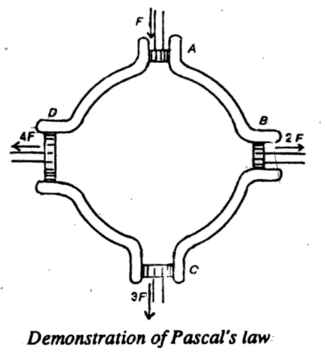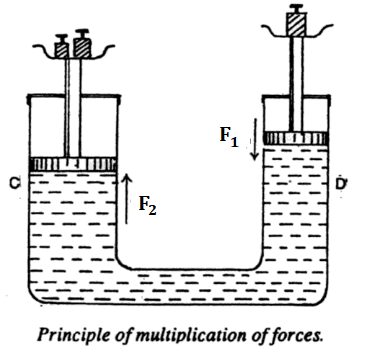Pascal’s Law:
A very useful law concerning the transmission of pressure was stated by Pascal in 1650.
Pascal’s Law states that if pressure is applied at any point in an enclosed fluid at rest, it is transmitted equally to all points of the fluid.

Pascal’s Law applies to all fluids- gases as well as liquids. In order to demonstrate the validity of Pascal’s Law, take a vessel in the form of a globe having a number of side tubes fitted with water-tight pistons. Fill the vessel completely with water and press one of the pistons. The other pistons will be found to come out. This shows that pressure is transmitted to every place in the liquid. Further, if the areas of the side tubes A, B, C, D, are in the ratio of 1 : 2 : 3 : 4, then when piston A is pushed inward with a force F then forces 2F, 3F, 4F must be applied on the pistons B, C, D, respectively to keep them in their original positions. This shows that pressure is transmitted undiminished as shown below.

Now suppose a force F1 is applied on the cylinder of a smaller cross-section. This causes external pressure on the confined water. The externally applied pressure is transmitted everywhere. It causes the piston of the larger cross-section to move up. The force F2 with which the water of the smaller cylinder lifts piston A2 is given by-
| F2 = PA2 Since P = F1/A1, we have F2 = F1(A2/A1) |
By making A2 > A1, the piston with the larger cross-section experiences many times bigger force than what has been applied on the piston of a smaller cross-section. For example, if A1 = 5 cm2, A2 = 500 cm2, then F2 = 100 F1. This illustrates what is known as the principle of multiplication of forces.
Applications of Pascal’s Law:
(1) Bramah’s Press- In this press the water-tight piston (ram) working in the wider cylinder C carries a platform. Above this platform, there is a fixed plate supported on pillars. The cotton bags (bale) which are to be pressed are placed on the platform. When the piston of the smaller cylinder D is lowered, the pressure inside increases due to which the ram moves up.
(2) Hydraulic Jack- The principle of the hydraulic jack is the same as that of the hydraulic press. In a hydraulic jack, the force is applied to the piston of a smaller cross-section. A car standing on the platform of the larger piston moves up as the piston of the smaller cross-section is gradually pushed inward.
(3) Hydraulic Brakes- A very important application of Pascal’s law occurs in the hydraulic system of brakes of automobiles. When the pedal of a master cylinder containing oil is pressed, the pressure is transmitted to four other cylinders, known as wheel cylinders. The piston working in each wheel cylinder expands the brake shoes of their respective wheels. Thus brakes are applied on all four wheels. When pressure on the brake pedal is released, the brake shoes are pulled back by the respective springs.
(4) Blood Pressure Measurement: Blood pressure monitors, like sphygmomanometers, use Pascal’s law to measure blood pressure. The pressure applied to the cuff gets transmitted through the fluid (air or liquid) to detect systolic and diastolic blood pressure.
(5) Hydrostatic Pressure in Liquids: Pascal’s law is used to calculate hydrostatic pressure in liquids, which is essential in various engineering applications like designing dams, reservoirs, and underwater structures.
(6) Hydraulic Steering Systems: Hydraulic steering systems in vehicles utilize Pascal’s law to make steering easier by using hydraulic pressure to assist the driver’s input.
(7) Pneumatic Systems: While not directly related to Pascal’s law, pneumatic systems (compressed gases) are often used alongside hydraulic systems in various applications, like air brakes in heavy vehicles and pneumatic tools.
Overall, Pascal’s law is a crucial concept in the design and operation of numerous mechanical systems, providing a basis for understanding fluid behavior and enabling the creation of efficient and powerful devices.









Comments (No)